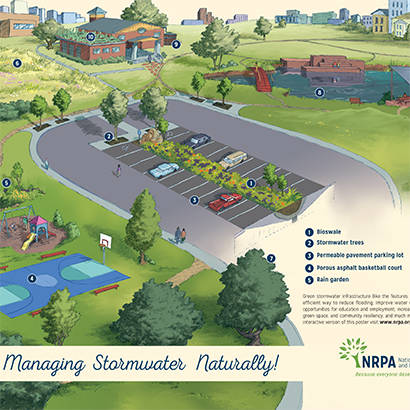
Park and recreation departments have the power to improve community resilience through their vast network of parks and open space. To further these efforts, in 2015, NRPA launched the Great Urban Parks Campaign, which promotes the use of green stormwater infrastructure (GSI) to reduce flooding in local parks, while also making many other positive benefits to their communities. NRPA also created the Green Infrastructure in Parks resource to help park and recreation professionals implement GSI in their park systems.
What was missing was how to measure the impact of that work. Specifically, how does green infrastructure affect not only the natural environment of communities, but also the health and even local economy surrounding the GSI?
NRPA’s Green Infrastructure Evaluation Framework does just that. This online resource gives park professionals the tools and information they need to evaluate the community benefits of their GSI projects in parks over the short and long term. Clicking through three easy steps of defining your project goals, collecting data and using that data for messaging your results, the framework will give you a detailed measurement plan and an approach for how to use the data.
A Look Inside the Framework
The framework makes data collection on the ground easy and practical through three key steps, each with text, downloadable tools and other resources.
Step 1: Define your benefits and measures. This first step clarifies the benefits a GSI project may bring to a park and the surrounding community, and what your agency should focus on measuring over time. Beyond the flood-reduction benefits of green stormwater infrastructure, GSI can also produce many other results, as illustrated in the chart below.
Step 1 provides an overview of how GSI and green space in parks produce the previously mentioned benefits. Your agency will have the information needed to determine what a GSI project may accomplish, and where your agency would like to focus your measurement. For example, if a GSI project involves replacing the cracking, gray surface under a playground with permeable pavement, you not only want to measure reductions in stormwater runoff near the playground, but also whether children and families are using the playground more often over time.
|
Benefit |
Details |
| Environmental |
|
| Health |
|
| Social |
|
| Economic |
|
Step 2: Collect your data. Once you have decided what to measure, Step 2 then outlines how to collect data on the ground. If your agency’s project focuses on increasing usage of a playground or walking trail, how will you know if you have succeeded? What measurement methods will you use to capture results over the next six months and beyond? You will walk away from this step being able to develop a detailed measurement plan that shows you how and when to collect data.
Receiving direct community feedback is critical for any GSI project. As a result, Step 2 also gives you practical tips on surveying community members about the impact of your agency’s project and a one-page survey that you can customize to your agency’s project.
Finally, you will learn about different evaluation models that you can choose based on your agency’s staff capacity, time and budget limitations.
Step 3: Use your data. One of the most common issues that we hear about from park and recreation professionals is what to do with the data your agency collects. Reporting on results can take both time and resources away from other critical activities, making it hard to fit in with other agency priorities.
Step 3 will help you explore how to harness GSI benefits data to improve future projects. You will gain practical tips on how to hold brief, productive performance conversations, and how to address successes and weaknesses with current projects.
Communicating the many benefits of GSI projects builds support for your agency and its work. Step 3 also explores how to broadcast your agency’s successes to the public and other key audiences. Learn best practices from other park organizations on how they have gotten the word out about their achievements.
How to Start Measuring Results
Measuring and communicating the many benefits of GSI projects will build public and elected support for green infrastructure and can contribute to future funding for this key conservation practice. The Green Infrastructure Evaluation Framework can help your agency make this happen. Further, though intended for measuring the benefits of GSI, your agency can adapt the framework to measure and communicate the conservation, health, social and economic impacts of many other projects, including pollinator habitats, green-space additions or even playground renovations.
You can start today by downloading the Green Infrastructure Evaluation Framework worksheets and other measurement tools. Like any toolkit, this framework will evolve over time, and NRPA is looking to you to use this resource and let us know how we can improve it. So, please share your comments and questions with me. I look forward to hearing from you.
Kevin Brady is NRPA’s Senior Evaluation Manager.

